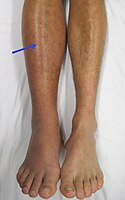
Photo from wikipedia
Background and Objective Recent trials showed that thromboprophylaxis with new oral anticoagulants (NOACs) is effective and safe in patients with cancer initiating chemotherapy. However, the cost effectiveness of NOACs is… Click to show full abstract
Background and Objective Recent trials showed that thromboprophylaxis with new oral anticoagulants (NOACs) is effective and safe in patients with cancer initiating chemotherapy. However, the cost effectiveness of NOACs is unknown. The objective of this study was to compare the cost effectiveness of preventing venous thromboembolism with NOACs with no thromboprophylaxis for patients with cancer initiating systemic chemotherapy from the perspective of the Chinese healthcare system. Methods A decision analytical model consisting of both acute and chronic venous thromboembolism complications was used to assess the cost effectiveness of thromboprophylaxis with NOACs vs no thromboprophylaxis. The key clinical data were derived from the CASSINI and AVERT trials. Costs, quality-adjusted life-years (QALYs), and incremental cost-effectiveness ratios (ICERs) were calculated for the two strategies. Scenario and sensitivity analyses were performed. Results Compared with no thromboprophylaxis, NOACs gained 0.072 QALY at an incremental cost of $US930, leading to an ICER of 12,919/QALY in patients with Khorana scores ≥ 2 by pooling the data from the CASSINI and AVERT trials. Among patients confirmed with no deep-vein thrombosis before thromboprophylaxis (the CASSINI trial) and patients without deep-vein thrombosis screening before thromboprophylaxis (the AVERT trial), the ICERs were $70,897/QALY and $87,204/QALY, respectively. The probability of NOACs being cost effective was 42% at a willingness to pay of $10,276/QALY. The ICER was sensitive to the relative risks of death and asymptomatic venous thromboembolism between NOACs and no thromboprophylaxis and the cost of NOACs. Conclusions Thromboprophylaxis with NOACs is not likely to be cost effective in patients initiating chemotherapy in the Chinese context. The decision about thromboprophylaxis should be tailored based on the survival of patients with cancer, the risks of venous thromboembolism, and major bleeding.
Journal Title: Clinical Drug Investigation
Year Published: 2020
Link to full text (if available)
Share on Social Media: Sign Up to like & get
recommendations!